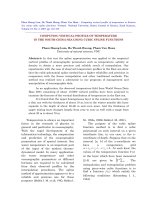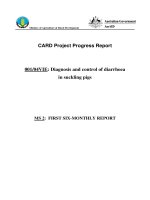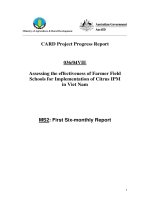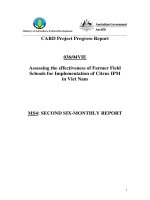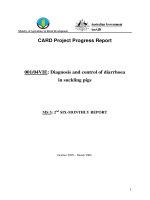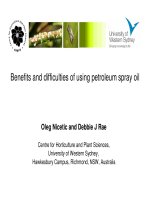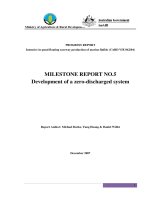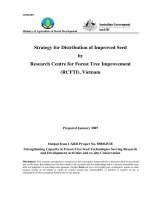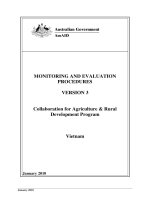Báo cáo nghiên cứu khoa học " Diagnosis and control of diarrhoea in suckling pigs - MILESTONES 3 and 6 " pptx
Bạn đang xem bản rút gọn của tài liệu. Xem và tải ngay bản đầy đủ của tài liệu tại đây (831.32 KB, 44 trang )
1
Ministry of Agriculture & Rural Development
Project Progress Report
Diagnosis and control of diarrhoea in suckling pigs
CARD Project 001/04VIE
MILESTONES 3 and 6
2
nd
and 3
rd
SIX MONTHLY REPORTS (COMBINED)
2
Table of Contents
1. INSTITUTE INFORMATION 3
2. PROJECT ABSTRACT 4
3. EXECUTIVE SUMMARY 4
4. INTRODUCTION & BACKGROUND 6
5. PROGRESS TO DATE 6
5.1 RESPONSE TO APPRAISAL 6
5.2 IMPLEMENTATION HIGHLIGHTS 7
5.3 SMALLHOLDER BENEFITS 14
5.4 CAPACITY BUILDING 14
5.5 PUBLICITY 15
5.6 PROJECT MANAGEMENT 15
6. REPORT ON CROSS-CUTTING ISSUES 15
6.1 ENVIRONMENT 15
6.2 GENDER AND SOCIAL ISSUES 15
7. IMPLEMENTATION & SUSTAINABILITY ISSUES 15
7.1 ISSUES AND CONSTRAINTS 15
7.2 OPTIONS 15
7.3 SUSTAINABILITY 16
8. NEXT CRITICAL STEPS 16
9. CONCLUSION 17
10. STATUTORY DECLARATION 18
PROJECT PROGRESS AGAINST PROPOSED OBJECTIVES, OUTPUTS, ACTIVITIES AND INPUTS 21
APPENDIX ONE 27
APPENDIX TWO 34
APPENDIX THREE 37
3
1. Institute Information
Project Name
Diagnosis and control of diarrhoea in suckling pigs
Vietnamese Institution
National Institute of Veterinary Research (NIVR)
Vietnamese Project Team Leader
Dr. Truong Van Dung
Australian Organisation
The University of Queensland/Victorian Department of
Primary Industry
Australian Personnel
Dr Darren Trott, Dr Ian Wilkie, Dr Tony Fahy
Date commenced
April 13
th
2005
Completion date (original)
January 2007
Completion date (revised)
April 2007
Reporting period
March 2006-March 2008
Contact Officer(s)
In Australia: Team Leader
Name:
Dr Darren Trott
Telephone:
617 336 52985
Position:
Associate Professor of Veterinary
Microbiology
Fax:
617 336 51355
Organisation
School of Veterinary Science The
University of Qld
Email:
In Australia: Administrative contact
Name:
Melissa Anderson
Telephone:
61 7 33652651
Position:
Manager Research Projects Office
Fax:
61 7 33651188
Organisation
School of Land and Food The
University of Qld
Email:
In Vietnam
Name:
Dr Cu Huu Phu
Telephone:
84 4 8693923
Position:
Head of Bacteriology Department
Fax:
84 4 8694082
Organisation
NIVR
Email:
4
2. Project Abstract
This project is designed to improve productivity of smallholder pig farmers in Vietnam through
improved health management, particularly of piglets during the pre-weaning period. Through
consultation and dialogue with farmers and field veterinarians, an appropriate disease
management plan will be developed. This will concentrate on the pre-weaning period where
greatest losses occur, but will include principles of herd health management in general.
Dissemination of the plan will be through training programmes for field staff and selected
farmers.
Additional to the health management plan the project will develop and implement appropriate
rapid diagnostic tests for the principal strains responsible for enterotoxigenic colibacillosis, to
improve speed and accuracy of laboratory diagnosis. The third part of the project is to improve
the production and efficacy of locally-manufactured E. coli vaccines. In particular, this will
involves including a unique local strain shown by previous research to be an important vector of
p
re-weaning disease in some, and possibly all, areas of Vietnam.
3. Executive Summary
This report, which is a combination of two six-monthly reports (2
nd
report and 3
rd
report),
documents progress on the following deliverables (linked to the project logframe objectives and
milestone descriptions):
1. Vaccine efficacy and safety data (Production and testing of locally-produced E. coli vaccine-
small scale and field trials Logframe Reference 1).
2. Enteric management plan and production parameter records at 10 selected farms (5 test and 5
control farms for a 12 month period) (Develop a management plan for preweaning diarrhoea
using a continuous improvement model-Logframe reference 2a and 2b).
3. Development of polyclonal sera and/or PCR incl. rapid detection of novel fimbrial antigens
(Improve diagnostics for preweaning diarrhoea-Logframe reference 3).
Progress has been achieved against all three objectives according to the project logframe,
although some significant problems were experienced in trying to identify the novel fimbrial
antigen present in Vietnamese O8 strains (christened F19), even with collaboration from the
world’s leading expert on enterotoxigenic E. coli in pigs for a period of 18 months (Professor
John Fairbrother, E. coli Reference Laboratory University of Montreal, St Hyacinthe, Quebec,
Canada). The E. coli reference laboratory is very close to identifying the protein, but has run out
of resources for the project. However, the positive benefits of interaction and collaboration with
Prof Fairbrother will lead to the development of a joint international funding application to
continue research and extension in Vietnam beyond the life of the current AUSAID CARD
programme at the end of 2009. Dr Fairbrother is planning to visit Vietnam in December 2009 and
begin the process of applying for a Gates Foundation grant to continue collaborative research
(focusing on a combination of holistic improvements to smallholder agriculture, public health and
novel analysis of E. coli evolution and recombination within animal and human hosts). A/Prof
5
Trott’s move to the University of Adelaide has also provided an opportunity, with the availability
of startup funds to attempt another large scale fimbrial purification in Prof Fairbrother’s
laboratory to identify the novel antigen by two dimensional protein gel electrophoresis. The
startup funds will provide Dr Do Ngoc Thuy with an airfare and living allowance to travel to
Canada in the summer of 2010 and complete the work.
In small scale trials conducted at NIVR, the ETEC vaccine (still encorporating F4, F5 and the
new F19 antigens) was proven to be safe and efficacious when administered to pregnant sows (2
doses at 5 and 2 weeks before farrowing). It is now being supplied to selected piggeries in North
Vietnam on a research only basis, with anecdotal reports of good efficacy against neonatal E. coli
infection and no reports of side-effects. The vaccine has also been produced for 004/05VIE and
used in the selected smallholder farms in central Vietnam in this related AUSAID project as part
of a Continuous Improvement Model to integrate best management practices into a holistic pig
production improvement plan.
Production data for the five test and five control farms over a 12-month period were analysed and
a statistically significant improvement in preweaning mortality was noted in the test farms (8.6%
± 3.6) over the trial period compared to the controls (15.6 ± 4.3; p<0.05). A bigger improvement
may have been confounded by the small sample size, but problems in the adoption of the
Continuous Improvement Model may also have had an impact (ie the benefits of using the
vaccine were not being realised due to the many endemic disease and production problems that
were beyond the scope of this initial project to improve). The major problem encountered from
the farm visits was inadequate uptake of skills, knowledge and recommendations by piggery
managers most probably caused by breakdown in communications between Vietnamese scientists
and piggery workers in the intervening periods between site visits by Australian scientists. The
National Institute for Veterinary Research scientists are, for the most part, laboratory based
researchers and we identified a training requirement in veterinary extension. We therefore
adopted a top down Train the Trainers approach in CARD004/05VIE which, for the large part,
has been successful in creating a subset of successful smallholder farmers in Central Vietnam.
Farm reports for September 2006 revealed that with a few notable exceptions, many of the farms
had not maintained the changes and recommendations suggested during the visit in 2005. The
major problems identified but still not addressed included poor ventilation, inadequate cooling
mechanisms and unacceptable heat index recordings, poor environment for suckers and weaner
pigs, restricted feeding of sows and poor breeding records (low number of growers for the total
number of sows). These factors may be contributing to the high incidence of enteric disease in
suckers and weaners as well as respiratory diseases in growers. Clearly addressing these multiple
problems is beyond the scope of the current project and has been addressed in 04/005VIE.
The PCR machine and rapid diagnostic assay kits purchased by the project continue to be used
for NIVR research on preweaning enteric diseases. A complete analysis of diagnostic results on
pre and post weaning diarrhoea, together with the results of safety and efficacy testing of the
vaccine were presented as posters by Dr Do Ngoc Thuy at the Australasian Association of
Animal Production Biennial Conference in Hanoi in September, 2008. A survey of 117 samples
of preweaning diarrhoea from commercial farms and 45 samples from village-based smallholder
farms confirmed the presence of multiple agents in both forms of agriculture, however, only the
commercial farms recorded cases of diarrhoea due to a single agent. By far the most common
agents identified were rotavirus and transmissible gastroenteritis virus, often as a mixed infection
with enterotoxigenic E. coli (ETEC was only ever isolated from older pigs as neonatal diarrhoea
seems to be controlled by vaccination with the imported vaccine Pfizer Littergard). These results
confirm that care of the sow and piglets during the preweaning period on both village and
6
commercial piggeries in Vietnam is suboptimal, which has been the major focus of initiatives
developed in 004/05VIE.
Characterization of virulence factors from ETEC isolates obtained from cases of pre- and
postweaning diarrhoea identified some interesting findings. Following the successful visit to Dr
John Fairbrother’s laboratory by Dr Thuy, 10 additional virulence genes were included that have
been linked with certain E. coli pathotypes in other studies. These included the genes for Paa,
AIDA-1, EAST-1, stx2 (normally associated with oedema disease) and Aero (normally a marker
for extraintestinal pathogenic E. coli) which were identified in the Vietnamese ETEC collection.
Firstly in pre-weaning diarrhoea, F4:Paa:STa:STb:LT:EAST-1 was still the most common
pathotype (it was also the most common pathotype observed during Dr Do Ngoc Thuy’s PhD
studies). During studies in Dr John Fairbrother’s laboratory, he identified that the virulence factor
pathotype Paa:STa:STb:LT:EAST-1 was a consistent marker for the O8 F19 isolates that possess
the new fimbrial type (thus they can be rapidly identified by their virulence gene profile even
though diagnostic antisera that was entirely specific for the O8 strains could not be produced in
Vietnam). This pathotype was the second most prevalent in the pre-weaning diarrhoea isolates,
indicating that it was still a significant pathogen in preweaning diarrhoea in Vietnam. In post-
weaning diarrhoea, the major pathotypes were associated with F18 rather than F4 and the
majority of F18 strains also possessed stx2 toxin, confirming that the isolates had the capability
of causing both post-weaning diarrhoea and oedema disease.
4. Introduction & Background
Diarrhoea during the suckling period has been recognised as the principle health problem
affecting both smallholder and commercial pig production in Vietnam. Previous research has
confirmed the presence of a new fimbrial type in E. coli strains causing colibacillosis in Vietnam
that would not be controlled by existing vaccines. Existing vaccines are currently imported into
Vietnam at considerable cost. In addition, there are many other causes of suckling diarrhoea, the
significance of which is currently unknown in Vietnam, which are all affected by husbandry and
management during farrowing and lactation. Project 001/04VIE (Diagnosis and control of
diarrhoea in suckling pigs) began with three objectives to solve this problem:
1. Production and testing of locally-produced E. coli vaccines
2. Development of a management plan for preweaning diarrhoea using a continuous improvement
(CIP) model
3. Improved field and laboratory diagnosis of preweaning diarrhoea
5. Progress to Date
5.1 Response to Appraisal
In general the previous report was well received and there were only two major issues that
required clarification:
The proponents state that this project is still in the data gathering stage. This second six-monthly
Milestone Report is about 10 months later than expected and given that the project is due for
completion in March 2007 (according to the Contract) there is some concern that about delivery
of 5 further milestones by this date. Can the project proponents please clarify this position?
7
All the data is presented and analysed in the current report. Unfortunately the requirements of
the 004/05VIE project were overwhelming and prevented timely submission of reports, even
though the work was completed within the specified timeframe (and the findings presented at two
major international conferences).
The presence of the new unique fimbrial type remains an issue. The proponents state that there is
a need for a survey to determine its incidence. Given that a key component of this project is
production of a vaccine for this (and other types) who is going to undertake such a survey and
how will the economic necessity for incorporation of the new unique type into existing or
Vietnamese produced vaccines be established?
The research work conducted in the laboratory of Prof John Fairbrother confirmed the typical
virulence gene pathotype of the unusual O8 (F19) strains, and work conducted by Dr Do Ngoc
Thuy and presented in this report confirmed that these strains are still prevalent in commercial
piggeries in Vietnam. The strains are likely to be present in smallholder farms, but have not been
detected as yet in the small number of samples processed by NIVR. The cost of inclusion of this
strain in the vaccine is minimal and far outweighs the risk of exclusion (ie widespread
vaccination with F4 and F5 strains would only increase the prevalence of the F19 strains).
5.2 Implementation Highlights
1) Vaccine strain characterization and further identification of the novel (F19) fimbrial antigen
present in O8 5F- strains (Note: A detailed report of activities is included in Appendix One:
Characterization of Vaccine Strains).
The NIVR E. coli vaccine strains were extensively and independently characterized. Attempts to
produce diagnostic antisera that was 100% specific against the novel O8 strains (as previously
reported) were unsuccessful and it was concluded that the laboratories in both Australia and
Vietnam lacked the expertise and equipment to perform a large scale fimbrial extract required to
purify the antigen. An opportunity for Dr Do Ngoc Thuy to visit the laboratory of Prof John
Fairbrother (the world’s leading porcine E. coli expert) immediately following the IPVS
Congress in 2006 was eagerly taken up. Dr Thuy performed initial experiments confirming to
Prof Fairbrother that the novel Vietnamese ETEC did indeed produce a mannose-resistant
adhesin at 37
o
C (highly indicative of production of fimbriae capable of attachment to
enterocytes), which was confirmed by transmission electron microscopy. An initial attempt at
purification of the fimbrial extract revealed that there were still some contaminating proteins. Dr
Thuy then returned to Vietnam and Prof Fairbrother continued the process of characterization.
Initial attempts at identifying proteins in the purified fimbrial extract were unsuccessful.
However, following a more rigorous extraction method, a 20KDa sized band (the right size!!)
was identified in SDS-PAGE gels as the putative adhesin as it reacted in a Western Blot with
hyperimmune serum obtained following immunization of rabbits with an E. coli O8 5F- whole
cell extract grown at 37
o
C to produce fimbriae and absorbed with sera obtained for the same
strain grown at 18
o
C, when it does not produce fimbriae. An N-terminal amino acid sequence
obtained from the band cut from a one dimensional SDS-PAGE gel identified a protein closely
related to Enterobacter ompX, but Prof Fairbrother is not convinced that this is the adhesin, even
though it has a putative attachment role in other bacteria. A problem is that the adhesin does not
seem to be expressed as much or as consistently as other fimbrial antigens and contaminating
proteins may be being identified instead of the true fimbriae. However, Prof Fairbrother has
produced diagnostic antisera that is now quite specific for the F19 antigen and screened a large
number of isolates from his collection (n=140) including all of the Vietnamese strains. This
identified the correlation between F19 and the virulence gene profile Paa/STa/ST/LT/EAST-1
8
which can be used as a marker for the strains. Prof Fairbrother is also assisting Dr Thuy in the
characterization of post-weaning diarrhoea and oedema disease isolates for a major paper.
2) Safety and efficacy testing of NIVR E. coli vaccine.
The NIVR prepared the vaccine for small scale trials according to the methodology detailed in
Appendix Two: Vaccine production protocol. Protection, safety and efficacy studies are shown
in Appendix Three: Results of Safety and Efficacy Studies of E. coli vaccine. In summary, the
vaccine offered piglets significant protection from lethal homologous challenge infection and
produced no unacceptable side effects in vaccinated gilts and their progeny. When compared to
Littergard and Ecovac, two commercially available vaccines from Pfizer and Intervet,
respectively, the NIVR vaccine produced statistically similar specific antibody titres to an E. coli
F4 fimbriae strain. This confirms that under experimental conditions, the vaccine is both safe and
efficacious. Small amounts of the vaccine are now being supplied to selected herds in the North
of Vietnam to obtain field data on its safety and anecdotal reports on efficacy. A true field trial is
planned to coincide with major farmer to farmer training initiatives in 004/05VIE.
3) Analysis of all production records from the five test farms and five control farms.
An analysis of preweaning mortality reported over a 14-month observation period established that
the test farms, which were subject to a number of recommendations during the life of the project,
had a significantly lower average pre-weaning mortality compared to the control farms (8.6% ±
3.6 vs 15.6 ± 4.3; p<0.05). One of the control farms was removed from the trial due to an
outbreak of hog cholera. For the majority of test farms, consistently lower pre-weaning
mortalities were sustained over the trial period, however for Dong May farm in Thai Binh, pre-
mortalities of close to 20% were reduced to 10% towards the end of the observation period. It is
difficult to determine whether this reduction in preweaning mortality was associated with uptake
of any of the previous visit’s recommendations as the same problems were still observed on the
second visit!
0.00
5.00
10.00
15.00
20.00
25.00
30.00
35.00
40.00
45.00
50.00
Apr-05
May-05
Jun-05
Jul-05
Aug-05
Sep-05
Oct-05
Nov-05
Dec-05
Jan-06
Feb-06
Mar-06
Apr-06
May-06
Jun-06
Month
% Pre Weaning Mortality
Anh De Thai Binh C
Anh Thiet Hung Yen C
Trang Due Hai Phong C
Minh Duong Ha Tay C
Dinh Dung Binh Dinh C
Dong My Thai Binh T
Anh Hiep Hung Yen T
Anh Tinh Hai Phong T
Thanh Bich Ha Tay T
Nhon Hoa Binh Dinh T
Figure: Average preweaning mortalities observed in five test (T) and five control (C) piggeries
during the 14-month observation period.
9
4) Farm visits to Northern Herds September 2006. A summary of the final farm visits to the
Northern herds is detailed in Appendix Four: Farm reports all September. For comparative
purposes, the farm audits from 2005 are included below each 2006 audit. Overall, whilst some
improvements were noted on individual farms, many of the recommendations made on previous
visits were not being followed. Drip coolers that had been installed were removed on some farms,
the farms were not operating to full capacity in terms of the number of sows vs the number of
growers and care of neonatal and weaner pigs was still not ideal.
Some of the disease problems were clearly linked to the unacceptably high heat index recorded in
some of the sheds, restricted feed intake and the large number of sows with low condition scores
and poor ventilation. Anh Hiep Farm (Hung Yen Province) perhaps showed the greatest
improvements over the life of the project, but this farm achieved consistently low rates of
preweaning mortality throughout the year.
5) Results of diagnostic investigations on pre-weaning diarrhoea.
Dr Thuy’s investigation of the causes of preweaning mortality in samples from commercial vs
village based piggeries provided some interesting results. Firstly, single disease agents were only
ever identified in commercial piggeries, but these only constituted 21.2% of total samples. By
contrast, multiple agents were always detected in enteric disease samples from village-based pigs.
In commercial piggeries, rotavirus and TGEV, or rotavirus, TGEV and enterotoxigenic E. coli
(ETEC) were identified in 26.3% of samples, indicating that these diseases are most certainly
endemic. These agents were also commonly detected as mixed infections in village piglets,
though samples from these animals were more likely to contain a “mixed bag” of pathogens.
Most of the samples were obtained from piglets older than 1 week, indicating that neonatal
diarrhoea is largely controlled (by the use of expensive imported vaccines) and that haemolytic E.
coli are most probably involved in scours in piglets greater than 14 days of age until weaning,
with the two most common pathotypes being F4/Paa/STa/STb/LT/EAST1 and the new signature
F19 pathotype, Paa/STa/STb/LT/EAST1. Coccidiosis was detected in 18% of commercial herd
samples and 35% of village pig samples. This disease can be easily controlled by strategic
preventive medication with toltrazuril (Baycox), administered at 3 days of age. Apart from
providing an ideal creep environment that is dry and warm, some simple measures that may
improve the diarrhoea due to rotavirus and TGEV include backfeeding a 1:20 dilution of the
scour (in water) to dry and pregnant sows to provide some maternal colostral antibody, and as
47.9% of commercial pig and 60% of village pig samples contain ETEC, strategic medication
with antimicrobials is also warranted. Use of drugs such as Lincospectin,
trimethoprim/sulphonamide and amoxicillin are preferred to enrofloxacin (which is banned in
food-producing animals in Australia). However, multiple drug resistance is likely to be
encountered (identified in Dr Thuy’s PhD thesis) and drugs that would probably be successful
include ceftiofur and apramycin. In Australia, 2-3 week scour due to ETEC is controlled by
feeding a milk vaccine to pregnant sows containing live “tame” E. coli strains (ie they contain F4
antigen but no toxins). It should be possible to identify these strains in the E. coli collection at
NIVR, but it is beyond the scope of this project. For scour occurring at the age of weaning or
postweaning scour, the following regime was suggested by Dr Tony Fahy. This involves
treatment with antibiotics, or if unsuccessful feeding a tame strain to sucker pigs 1 week before
weaning:
Farm to ensure that new weaners are in a draught free pen. This means enclosing the pen
with walls (eg used feed bags) and putting covering on about one third of the floor areas, in
the zone heated area, where the pigs will lie (eg used feed bags).
Place zone heaters over the floor area that is covered by bags.
1
0
The temperature needs to be 30-32 ‘C in the first week after weaning. This should be lowered
by 2 degrees each week by lifting the heaters up.
Piglets should be offered glucose and electrolyte solution in drinkers. A water soluble
antibiotic (that Thuy will identify) must be added to this drinking solution. This solution is
used for fourteen days post weaning.
Any pig that scours is to be treated (injectable) with the antibiotic recommended by Thuy.
Any piglets that scour are to have a rectal swab taken at the time of treatment (NOT AFTER
treatment).
If this strategy is not successful you will have to orally vaccinate the sucker piglets one week
before weaning.
Oral Vaccine procedure
This can only be done if the E. coli isolate does not have STa.
To be cautious test it on two litters in the first week, four litters in the next week and then if
there are no problems all litters can be treated the next week. If the vaccine causes a scour
treat the scouring piglets with Baytril.
Thuy will provide a UHT skim milk inoculum for the production of the vaccine.
The vaccine will be made by adding 100 ml of inoculum to 900 ml of UHT skim milk and
incubating overnight at around 37’C.
This vaccine is fed to the sucker piglets by adding 1 ml of it to 250ml of glucose electrolyte
solution per pig.
This is done for four consecutive days for each litter.
Three days before the inoculum is added pigs are offered the glucose electrolyte solution so
that they are used to drinking it.
This will provide an opportunity to determine how much fluid is drunk in one day.(ie if a
whole litter of 9 pigs drinks 1500ml you will add 9 mls of inoculum to the 1500mls so the
piglets get 1 ml each)
Table 1: Prevalence of enteric pathogens in pre-weaning piglets with diarrhoea (commercial vs
village herds).
Agent(s) detected # of positive specimens (%)
Commercial
(n=117)
Village (n=45)
Cocci 2 (1.7)
Crypto
3 (2.5)
RV
3 (2.5)
TGEV
11 (9.3)
ETEC
4 (3.4)
C. per. 2 (1.7)
Total single infections 25 (21.2)
RV ETEC 6 (5.1)
1
1
RV TGEV
17 (14.4) 3 (6.7)
Cocci
RV
1 (0.8) 2 (4.4)
CocciCrypto
1 (0.8) 2 (4.4)
Crypto
ETEC
3 (2.5) 1 (2.2)
Crypto
C. per. 1 (0.8) 1 (2.2)
Crypto
TGEV
6 (5.1) 2 (4.4)
TGEV
C. per. 1 (0.8)
TGEVETEC 7 (5.9)
Cocci RV ETEC 2 (1.7) 3 (6.7)
Cocci
RV TGEV
4 (3.4) 3 (6.7)
Cocci
TGEVETEC
2 (1.7) 2 (4.4)
CocciCrypto RV
1 (0.8) 1 (2.2)
Crypto
TGEVETEC
5 (4.2) 4 (4.4)
Crypto RV
ETEC
1 (0.8) 3 (6.7)
Crypto
TGEV
C. per. 1 (0.8) 1 (2.2)
Crypto RV TGEV
3 (2.5)
RV TGEVETEC
14 (11.9) 7 (15.6)
RV TGEV
C. per. 1 (0.8) 1 (2.2)
RV
ETEC C. per. 2 (1.7) 3 (6.7)
TGEVETEC C. per. 2 (1.7)
Crypto RV TGEVETEC 2 (1.7) 1 (2.2)
Crypto RV
ETEC C. per. 1 (0.8) 2 (4.4)
CocciCrypto RV TGEV
1 (0.8) 1 (2.2)
CocciCrypto
TGEV
C. per. 1 (0.8)
Cocci RV TGEVETEC 4 (3.4) 1 (2.2)
CocciCrypto RV TGEV
C. per. 1 (0.8) 1 (2.2)
Crypto RV TGEVETEC C. per. 1 (0.8)
(36) (50) (97)(111) (76) (23)
Total multiple infections 92 (78.8) 45 (100.0)
1
2
6) Characterization of E. coli virulence factors.
Dr Thuy’s analysis of virulence factors in ETEC isolates obtained from both preweaning and
postweaning piglets also provided some interesting findings and comparisons between
commercial and village pigs. Firstly, given the information from Prof John Fairbrother’s
laboratory on the typical virulence gene profile possessed by the F19 O8 strains, Dr Thuy was
able to demonstrate that in the case of preweaning diarrhoea samples from commercial pigs, the
F19 strains were the second most common virulence profile identified after the typical F4 strains.
These isolates were only identified in samples from commercial piggeries. In the case of the
postweaning diarrhoea samples, a large number of pathotypes were identified, but 73.2% of the
isolates possessed F18 fimbriae (and are likely to be serotype O141) whereas only 14.6% of the
isolates carried the more common F4 (and are likely to belong to serotype O149). F4 strains are
only associated with postweaning diarrhoea, whereas F18 is often associated with both
postweaning diarrhoea and oedema disease. As an indication of this, stx2, the toxin mostly
associated with oedema disease, was identified in 76.7% of the F18-positive isolates (63.4% of
total isolates). In most pig-producing countries, oedema disease has become quite rare, but it is
obviously still a serious disease in Vietnam (and has been observed in smallholder pig farms in
Central Vietnam during our 04/005VIE project). NIVR does produce an effective oedema disease
vaccine which requires further development and commercialization.
1
3
Table 2: Pathotype of E. coli isolates from cases of pre-weaning and postweaning diarrhoea in
commercial and village pigs.
Source of isolates
Pathotype
PrWD (n=18) PWD (n=41)
F4/STa/STb
1
F4/ Paa/STa/STb/LT/EAST1 5
F4/Paa/STb/LT/EAST1
5
F4/Paa/STb/LT/EAST1 2
F4/STa/STb/EAST1 1
F4/STa/STb/Aero 1
F5/Paa/STa 2
F18/STa/STb
2
F18/STa/EAST1
1
F18/AIDA-I/STa/STb
3
F18/Paa/AIDA-I/STa/Stx2
2
F18/AIDA-I/STb/Stx2
1
F18/LT/Stx2
1
F18/AIDA-I/STa/STb/Stx2
4
F18/Paa/AIDA-I/STa/STb/Stx2
3
F18/Paa/STa/LT/Stx2
13
Paa/STa/LT/Stx2
2
Paa/STa/STb/LT/EAST1 4
AIDA-I/STb/EAST1 1
AIDA-I/STb/LT/EAST1 1
STa/STb 1
STb/EAST1
1
LT/Stx2
2
1
4
5.3 Smallholder Benefits
Whilst this initial project has focused on monitoring herd health in commercial-sized piggeries,
considerable downstream benefits will flow to smallholder farmers as follows:
1) Characterization, efficacy and safety testing of the NIVR E. coli vaccine. Currently, the
majority of commercial piggeries in Vietnam use Pfizer Littergard at a price of approximately
$0.70 USD per dose. The majority of smallholder farmers currently do not practice vaccination
and could not afford to routinely use the commercial vaccine, unless it was purchased by a co-
operative of farmers. The Vietnamese vaccine could be produced at $0.15 USD per dose. Our
intended purpose is to register this vaccine, but in order to do so we must conduct a
comprehensive field trial. The farms developed in 004/05VIE present an ideal opportunity for
this to occur as the farmers are now raising piglets with good hygiene in dry, warm
surroundings. In addition, there is a ready supply of “control” farms located nearby where data
could be gathered on the incidence of diarrhoeal diseases, including ETEC in the first week of
life.
2) Identification of the causes of pre-weaning diarrhoea in smallholder farms. The completed
study by Dr Do Ngoc Thuy confirmed that in smallholder piggeries, single aetiological agents
of preweaning diarrhoea were never identified and the most common, multifactorial diseases
included TGEV, rotavirus and enterotoxigenic E. coli. Coccidiosis, a completely preventable
disease, was also detected in over 30% of diarrhoea samples. This confirms that before any
improvement in piglet health can be attained, we must start back at the basics and teach farmers
about sow microclimate (cool, dry) and piglet microclimate (warm, dry). Stressed, wet piglets
subjected to drafts and poor air quality succumb to diseases.
3) Identification of ETEC pathotypes in smallholder farms. Characterization of the ETEC isolates
obtained from smallholder farmers confirmed that the major ETEC pathotype in smallholder
farm enterprises is F4:Paa:STa:STb:LT:EAST-1. This pathotype causes neonatal, 2-3 week old
and postweaning scour and can be controlled by appropriate antimicrobial treatment or a
combination of sow and piglet killed and live vaccines. The unusual F19 strains, so far, have
not been identified in smallholder farms.
5.4 Capacity Building
NIVR has developed skills in the isolation and identification of major pig pathogens causing
preweaning diarrhoea, using a combination of culture, ELISA test kits and faecal floatation/faecal
microscopic examination. This capacity could easily be scaled up so that NIVR then teaches
other laboratories, including diagnostic laboratories how to accurately identify pig pathogens,
particularly those involved in pre-weaning diarrhoea. We have demonstrated that all the major
causes of pre-weaning diarrhoea on a worldwide basis are present in Vietnam, often in mixed
infections, with rotavirus, TGEV and ETEC predominating in commercial pigs and the same
agents dominating in village based smallholder farmer pigs with the important addition of
coccidiosis. Accurate identification of these agents is required, both on clinical suspicion (each
agent causes different clinical signs and affects pigs at different ages, however in the case of
mixed infections this may be more difficult to detect) as well as laboratory grounds. Two major
disease causing agents (ETEC in the first week of life and coccidiosis at 6-14 days of age) are
easily preventable by vaccination of the dam in the case of ETEC and preventative treatment with
toltrazuril at 3 days of age in the case of coccidiosis. However, without extreme improvements in
the care and husbandry of piglets during the crucial pre-weaning period, any perceived benefits
will not be attained.
1
5
Our research has shown that NIVR has produced a very successful vaccine that has been proven
to be both safe and efficacious in small scale trials and elicits similar antibody levels to
commercially available vaccines. Taking this to the next phase of commercialisation has proven
to be difficult and we have been unwilling to attempt any controlled field trials until such we are
confident that our smallholder farmers have improved their standards of husbandry. A large field
trial is planned in central Vietnam as part of 004/05VIE in order to finalise both projects under
our direction. All data will be obtained in such a way as to support eventual registration of the
vaccine.
5.5 Publicity
Unfortunately the negative publicity surrounding NIVR and the production and sale of
unregistered vaccines in 2008 is not the sort of marketing tool that we like to brandish. However,
this does present an opportunity to understand why some of these events occurred. There is a
tremendous need in Vietnam for locally produced, cheap and safe vaccines that can be used by
smallscale farmers and NIVR has produced some very successful vaccines. However, they have
limited experience and resources in following the path to commercialization and registration. We
will use the ETEC vaccine as the paradigm for effective interrelationships with MARD and the
Department of Animal Health to conduct a field trial and successfully negotiate the path to
commercialisation. We will also seek to patent Dr Thuy’s vaccine through the Office of
Intellectual Property of Vietnam within the Ministry of Science and Technology. This will
enhance the reputation of NIVR as a quality research establishment and provide much needed
funds through a royalty stream to upgrade facilities and continue to conduct first rate research.
Other vaccines, such as the oedema disease vaccine could be taken along a similar path once the
ETEC vaccine is successfully launched into the market.
5.6 Project Management
No major developments have taken place apart from the retirement of Dr Steve Driesen from the
Victorian Department of Primary Industries.
6. Report on Cross-Cutting Issues
6.1 Environment
Environmental impacts, gender and social issues are more appropriately discussed in the
O4/005VIE project reports as these have significant downstream benefits to smallholder farmers,
their families and the immediate environment.
6.2 Gender and Social Issues
7. Implementation & Sustainability Issues
7.1 Issues and Constraints
7.2 Options
Issue 1: Commercialisation of the NIVR vaccine.
1
6
Constraints: There is considerable investment in time and money involved in the path to
commercialisation of the vaccine. This could result in many delays until the eventually
availability of the vaccine for smallholder farmers.
Options: We have been advised that the best way forward is for Dr Thuy and NIVR to patent
their vaccine through the Office of Intellectual Property of Vietnam. In this endeavour, we will
seek the advice and assistance of a patent attorney and seek to make partnerships with vaccine
manufacturers in Vietnam who hold a GMP/GLP licenses for vaccine production (eg
NAVETCO), with a royalty stream flowing back to NIVR and the inventors which can be used to
fund future research. The research conducted to date can be used to support the application,
including the planned field trials in central Vietnam to coincide with 004/05VIE project aims.
This model could be successfully used for other NIVR vaccines that are equally effective, but not
yet registered and this could be an extremely effective marketing tool. The assistance of the
CARD programme management team is sought to assist in this process by reiterating that the
availability of a viable, cheap locally produced vaccine for smallholder farmers is the major
outcome we are seeking to achieve and the assistance of the relative authorities is required so that
this can be fast tracked to completion.
7.3 Sustainability
The issues of sustainability as we are coming to the end of this project can be discussed under
three broad schemes:
1. Production and testing of locally-produced E. coli vaccines
This has been discussed at length. The availability of leftover funds once the 004/05VIE project
is completed will need to be used to further the path to commercialization and complete the
analysis of field trials in Central Vietnam.
2. Development of a management plan for preweaning diarrhoea using a continuous
improvement (CIP) model.
This theme has been carried into 004/05VIE where we are seeking to develop a core of successful
farmers and has been extended to a holistic approach to pig production. We are now at the stage
in 004/05VIE where we can conduct a field trial on the NIVR vaccine AND a prevalence study
for causes of preweaning diarrhoea in test farms (those that have received an upgrade to their
facilities and knowledge and skills) and control farms (those that were initially surveyed but did
not receive advice). Our legacy will be a nucleus herd in central Vietnam that becomes the model
for successful smallholder production in other regions.
3. Improved field and laboratory diagnosis of preweaning diarrhoea.
As part of the fulfilment for 2), NIVR will transfer their knowledge and technology obtained in
the diagnosis of preweaning diseases to Hue University of Agriculture and Forestry which will
then provide the diagnostic service for the region.
8. Next Critical Steps
1) Complete vaccine field trial and prevalence study of enteric diseases in central Vietnam (Dec
2009-Feb 2010).
2) Transfer technology for diagnosis of preweaning enteric diseases to Central Vietnam (Dec
2009-Feb 2010).
3) Continue negotiations and pathways towards registration of the NIVR E. coli vaccine (Oct
2009-April 2010).
1
7
9. Conclusion
This combined milestone report details the considerable research and effort by NIVR and
Australian scientists to achieve project success within the logframe. Apart from the complete
characterization of the F19 antigen, all objectives have been fulfilled and remaining milestones
will be relatively straightforward. Even the further characterization of the F19 antigen from non-
project funds provides an opportunity for continued sustainability of the project and longterm
international funding collaborations. Difficulties experienced in seeking the right pathway for
commercialization of the vaccine will provide a technology platform for taking additional locally
produced vaccines through to commercialization and will provide a continued funding stream for
NIVR. Persistent application of the CIP model on the selected test commercial farms did show a
difference in preweaning mortality compared to the control commercial farms and the lessons
learnt in technology transfer have been applied to 004/05VIE to work more specifically with
smallholder farmers.
1
8
10. Statutory Declaration
COLLABORATION FOR AGRICULTURE AND RURAL DEVELOPMENT PROGRAM
CARD Project Title: - Diagnosis and control of diarrhoea in suckling pigs
CARD Project Number: - 001/04/VIE
We the undersigned hereby declare that during the period 01/04/2006 to 31/09/2008 we have
delivered the following inputs to assist in implementation of the above project.
1: PERSONNEL INPUTS
Australian Personnel
Provided (Name)
Days in
Vietnam
Days in
Australia
Trips to
Vietnam
Dr Tony Fahy 20 12 2
Ms Karen Moore 10 12 1
Dr Trish Holyoake 0 0 0
Dr Darren Trott/Dr Ian Wilkie 10 12 1
Total 40 36 4
Vietnamese Personnel
Provided
Days in
Vietnam
Dr. Truong Van Dung 0
Dr. Cu Huu Phu 24
Dr. Do Ngoc Thuy 48
NIVR Diagnostic Laboratory
Staff
24
1
9
2: EQUIPMENT AND OTHER SERVICES
Equipment & Other Services Description Budget Limit
Signed for the Australian Institution by a duly
authorised officer in the presence of witness
Signature of Witness
Insert Name and Title
Insert Name and Title
3; EQUIPMENT AND SERVICES HANDOVER
This is to certify that the above personnel inputs have been delivered and the equipment
and services identified above provided has been handed over to the Lead Vietnamese
Institution
Signed for the Vietnamese Institution by a
duly authorised officer in the presence of
witness
Signature of Witness
2
0
Insert Name and Title
Insert Name and Title
21
Project Progress Against Proposed Objectives, Outputs, Activities
And Inputs
Project Title: Diagnosis and control of diarrhoea in suckling pigs
Vietnamese Implementing Institution: National Institute of Veterinary Research
PROPOSAL PROGRESS REPORT
Narrative Information Required Performance Measures Assumptions Information Required
OBJECTIVES
1.Production and testing of locally-
produced vaccine
2a. Enteric management plan for
preweaning diarrhoea
1.a. Identification and confirmation
of components, including novel
strain
1.b. Formulation of vaccine
1.c. Efficacy testing of vaccine
1.d. Field testing of vaccine
1.e. Commercial realisation of
vaccine
Quantitative data on piglet health,
survival and growth rates
Incidence and nature of
preweaning diseases
Confirmation and identification of
the mechanisms of the novel
pathogen
Preparation of antigen for
vaccination and diagnostic
reagents
Production of vaccine
Safety and efficacy tests completed
in NIVR
Field trials completed
Vaccine batch records scrutinized
Workshop with stakeholders
produces acceptable management
plan.
Implementation of plan on
demonstration farms
Training of facilitators to
disseminate to other provinces and
regions
Supply of training material
Decrease in preweaning mortality
Workshop feedback surveys,
certified training records
N
ovel pathogen is similar in
pathogenicity to existing strains
and will respond in a similar
manner. Preliminary work
suggests this is true.
Workshops with stakeholder group
will result in a coherent approach
and workable management plan.
Characterization of the vaccine
strain, in particular the isolation of
novel fimbriae and identification o
f
the genes encoding the fimbriae
was undertaken by Dr Do Ngoc
Thuy in the laboratory of Dr John
Fairbrother, Montreal Canada. The
purified fimbriae can be used to
produce diagnostic antisera.
Characterization is complete (apart
from the gene identification of the
F19 positive strains)
Efficacy and safety testing is
completed
After our first workshop and farm
visits, we immediately identified
that there would be a breakdown in
information and technology
transfer from the Australian
Scientists to the producers because
of a general lack of training of
veterinarians with herd health
management skills. We therefore
22
2.b Continuous improvement plan
(CIP)
3. Improved diagnostics for
preweaning diarrhoea
Stakeholder beneficiaries and
recipients of training / capacity
building:
-smallholder farmers
-large commercial piggeries
-NIVR laboratory staff
-NIVR vaccine production
Subinstitute
Analysis of data acquired during
and after project
Extension workers trained in herd
health management techniques
Information specific to local
conditions.
Reagents to improve speed and
accuracy of field and laboratory
diagnosis
Disease monitoring and
surveillance, implementation of pig
management recording services
Protocols developed, instructional
materials prepared, training of field
and laboratory staff continuing
Compilation and delivery of
training materials and successful
completion of training modules for
laboratory staff (Aust. and
Vietnam)
Availability of validated reagents
Training of field staff in gross
diagnostic techniques
Ability to assign mortality to a
category
That stakeholder demand will
maintain interest and input
commensurate with productivity
gains
Adequate laboratory capability
Timely development of reagents
developed the philosophy of “train
the trainers” and applied this to
004/05VIE
Selected demonstration farms
collected data on preweaning
mortality-test farms were
significantly different from
controls. The CIP model is being
reinforced with each visit to
Vietnam.
As above, we have identified
another layer of training with
highly trained Vietnamese
scientists giving the workshops and
facilitating hands on training. This
will be more fully explored in
CARD project 004/05VIE
Techniques have successfully been
transferred, accurate data on causes
of enteric diseases in suckling pigs
has been compiled for both
commercial and smallholder
farmers
OUTPUTS
1. Local ETEC strains confirmed
and characterised.
Technologies:
Large scale
production of locally produced
vaccine that is efficacious against
all strains of ETEC
Data compiled, strains isolated and
preserved
Vaccine strains cultured and
combined
As above
Whole cell immunization of
rabbits for production of
polyclonal antisera to identify
novel O8 F- strains was
successfully completed in Canada
23
2a. Enteric management plan for
preweaning diarrhoea
2.b Continuous improvement plan
(CIP)
Institutional capacity:
Improved
diagnostic reagents produced at
N
IVR for accurate investigation of
disease on farm/vaccine field trials
with particular respect to new
fimbrial type.
Financial benefits:
NIVR
Subinstitute increased vaccine
production for distribution
throughout Vietnam.
Improved production at reduced
cost through use of cheap local
vaccine, less reliance on
antimicrobials, reduced build up of
antimicrobial resistance (both
commercial and smallholder
producers)
Export products
: Pork products-
reduced public health concern re
antimicrobial resistance, improved
production at reduced cost.
Vaccine could be exported to
neighbouring countries such as
Laos and Cambodia
Knowledge:
Farm reports and
farm audits; herd health monitoring
Institutional capacity:
Scientists
trained to conduct audits/provide
advice;
Financial benefits:
creation of
model farms for demonstrating
how changes in management can
improve production and financial
profitability; records and farms can
Data from field trials collected and
compiled
Data collected from farms
Reduced preweaning mortality
Field data collection and analysis
Income estimations of farmers
Written and verbal communication
records/evidence of ongoing
fieldwork
Record of training certificates
issued to animal health
workers/producers and feedback
survey results
As above
and identified a unique virulence
gene profile for the O8 strains
(now christened F19 strains).
An unexpected opportunity arose
for NIVR staff to receive further
training to identify the novel
antigen in another laboratory
working with world experts in the
field who are very interested in the
novel strains. The work will lead to
future international funding
applications.
With full and ongoing support
from NIVR, test farms have been
audited twice more to continually
reinforce the CIP model. Some
farms have adopted the
recommended changes whilst
others have not. However without
further appropriate training of
Vietnamese veterinarians to be
able to independently conduct farm
audits and recommend changes,
full adoption of management
changes and continuous
improvement will be limited and
24
3. Improved diagnostics for
preweaning diarrhoea
then be used in future workshops
for training smallholder farmers
Social outcomes:
Meaningful
training for rural women in herd
management
Technologies and Knowledge:
Supply of rapid diagnostic reagents
and appropriate training to NIVR
for rapid and accurate diagnosis of
the six major causes of pre-
weaning diarrhoea
Institutional capacity:
Capacity for
accurate and timely complete
diagnostic service at NIVR for
specimens received from trial
farms (faecal specimens and faecal
swabs).
Financial benefits:
improved
knowledge of major diseases
limiting production and best
methods for control
Social outcomes:
Majority of
N
IVR lab staff are women
Improved ability to diagnose
disease accurately and rapidly
More accurate analysis of causes
and age at mortality
As above
unsustainable. This is being
addressed in CARD project
004/05VIE.
N
IVR laboratory is accurately and
rapidly determining the causes of
preweaning diarrhoea on the test
and control farms. The data has
been compiled and presented at
two major international
conferences.
ACTIVITIES
Organise initial training workshops
in Australia and Vietnam (2a)
Sourcing co-operating farms (1, 2a,
2b)
0-2 months
0-3 months
Initial Australian site visit by
N
IVR and 1
st
Vietnamese
workshop completed
Test and control farms (5 each)
selected in all provinces. Each
farm audited three times.
25
Implementation of pig health
recording services (2a, 2b)
Training extension staff in data
recording and risk analysis
identification (2a, 2b)
Characterise novel ETEC strain (1)
0-6
months
0-12 months
(revised to 0-24 months)
0-6 months
(revised to 0-24 months)
Pig health recording services
initiated for each farm. Data being
collected and farm audited by
Australian Scientists three time
during the reporting period
(November 2005; February 2006;
September 2006)
After the first workshop, it was
clear that training of extension
staff will require additional time
and resources not allocated in the
p
resent project. “Train the trainers”
in a “holistic approach to
improving all stages of production”
has become the theme for CARD
project 004/05VIE focusing on
smallholder production. The farms
established in the current project
together with the production
records obtained will be important
training resources.
Analysis of herd records for the
test and control farms confirmed
that preweaning mortality was
significantly reduced on the test
farms
Lack of specificity in the prepared
diagnostic antisera, necessitated
technical changes to antigen
production and partly because of
new opportunities arising to
conduct further characterisation in
another laboratory. Specific
antisera has been developed in
Cnada, but the gene for the novel
